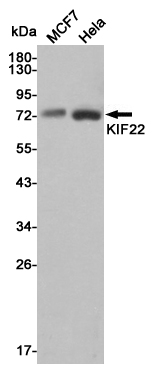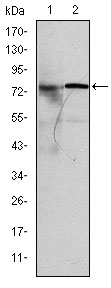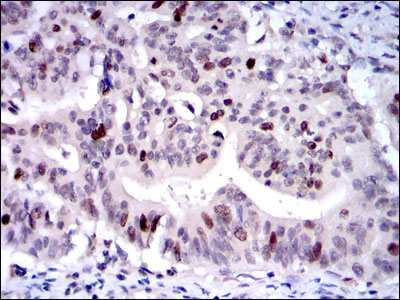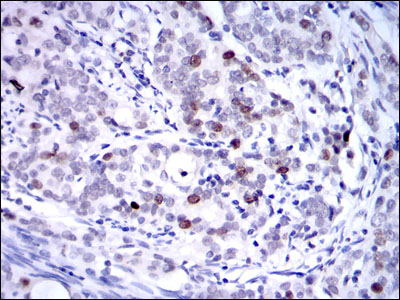-
Product Name
Anti-KIF22 (2E11) Mouse antibody
- Documents
-
Description
KIF22 (2E11) Mouse monoclonal antibody
-
Tested applications
WB, IHC-P
-
Species reactivity
Human
-
Isotype
Mouse IgG1
-
Preparation
Antigen: Purified recombinant fragment of human KID expressed in E. Coli.
-
Clonality
Monoclonal
-
Formulation
Ascitic fluid containing 0.03% sodium azide.
-
Storage instructions
Store at 4°C short term. Store at -20°C long term. Avoid freeze / thaw cycle.
-
Applications
WB: 1/500 - 1/2000
IHC: 1/200 - 1/1000
ELISA: 1/10000
-
Validations

Western blot analysis of extracts from MCF7 and Hela cell lysates using KIF22 mouse mAb (1:1000 diluted).Predicted band size:73KDa.Observed band size:73KDa.

Western blot analysis using KID mouse mAb against MCF-7 (1) and Hela (2) cell lysate.

Immunohistochemical analysis of paraffin-embedded rectum cancer tissues using KID mouse mAb with DAB staining.

Immunohistochemical analysis of paraffin-embedded cervical cancer tissues using KID mouse mAb with DAB staining.
-
Background
Swiss-Prot Acc.Q14807.The protein encoded by this gene is a member of kinesin-like protein family. This family of proteins are microtubule-dependent molecular motors that transport organelles within cells and move chromosomes during cell division. The C-terminal half of this protein has been shown to bind DNA. Studies with the Xenopus homolog suggests its essential role in metaphase chromosome alignment and maintenance.
Related Products / Services
Please note: All products are "FOR RESEARCH USE ONLY AND ARE NOT INTENDED FOR DIAGNOSTIC OR THERAPEUTIC USE"
